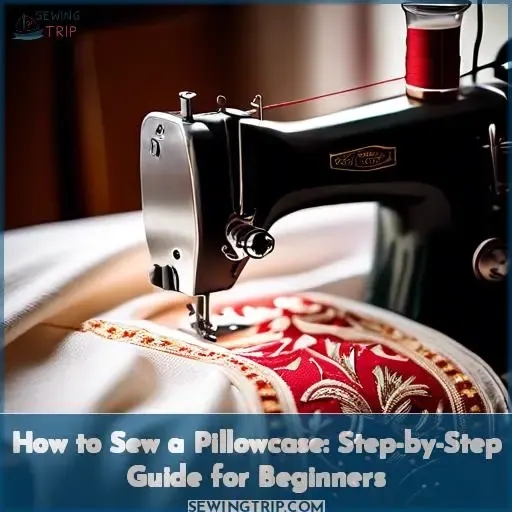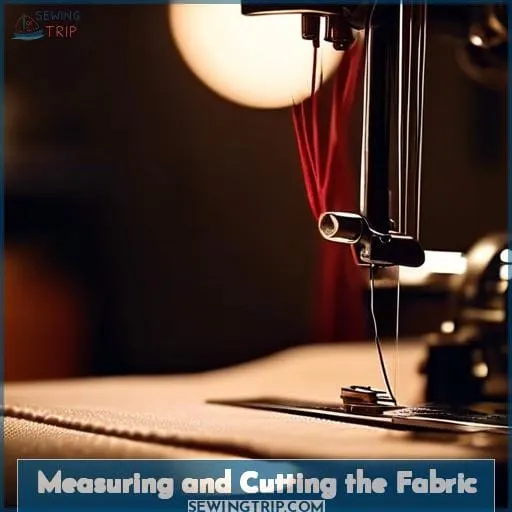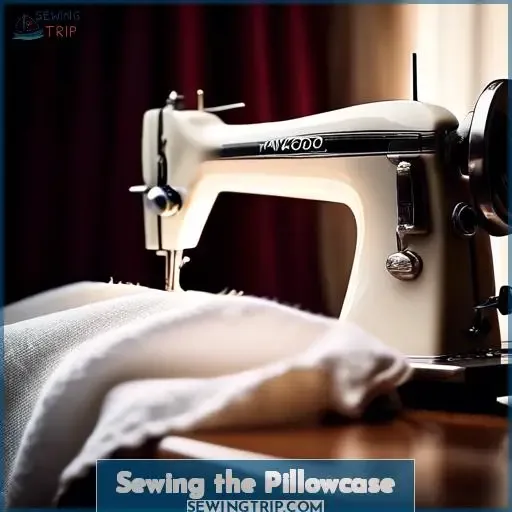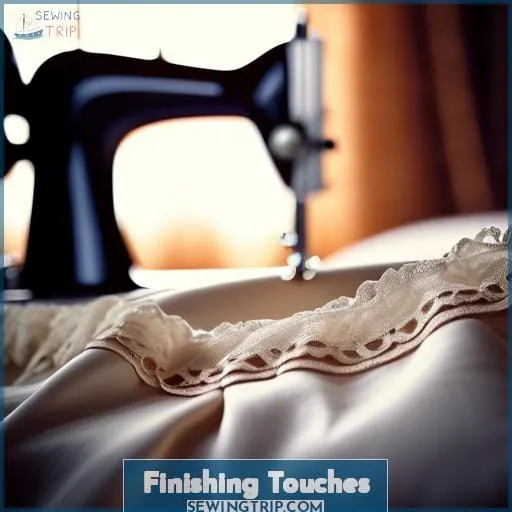This site is supported by our readers. We may earn a commission, at no cost to you, if you purchase through links.
 Embarking on a sewing journey might seem like stepping back in time, a nod to when creating with your hands was a daily necessity.
Embarking on a sewing journey might seem like stepping back in time, a nod to when creating with your hands was a daily necessity.
Yet, here you are, ready to blend tradition with innovation as you learn how to sew a pillowcase with a sewing machine.
This guide is your compass, pointing you towards mastery in crafting a cozy haven for your dreams.
From selecting the perfect fabric to adding those personal touches that make it uniquely yours, you’re about to embark on a creative adventure.
Let’s stitch your way to a custom comfort, transforming a simple piece of fabric into a pillowcase that cradles your aspirations, night after night.
Yes, you can sew a pillowcase with a sewing machine by cutting fabric to size, folding, ironing, pinning, and sewing the pieces together, then flipping it right side out. This beginner-friendly project transforms fabric into a custom pillowcase in a few simple steps.
Table Of Contents
Key Takeaways
Making a pillowcase is a simple and enjoyable sewing project suitable for beginners, offering an opportunity to personalize your bedding with various fabrics and patterns. The standard pillowcase size requires fabric measuring 27 x 40 inches, with an optional cuff adding a contrasting design element.
Sewing involves basic steps: folding the fabric right sides together, sewing the long side and one short side with a ½ inch seam allowance, and finishing with a hem on the open side. Personal touches like embroidery, appliques, or fabric paint can transform a basic pillowcase into a unique and custom piece.
Gathering Materials
Before you start sewing your pillowcase, you’ll need to gather a few essential materials.
First, choose your fabric—quilting cotton, flannel, or satin are great options depending on the feel you’re going for.
Then, make sure you have all your basic sewing supplies ready: a sewing machine, thread, scissors, pins, and a measuring tape.
If you’re feeling adventurous, consider adding a contrasting fabric for the cuff or trim to give your pillowcase a unique touch.
Select Fabric: Quilting Cotton, Flannel, or Satin
Choosing the right fabric for your pillowcase project is like picking the perfect outfit for a first date—it sets the tone!
Quilting cotton, with its sturdy charm, is the reliable choice, offering both durability and a vast array of designs to match your bedroom’s vibe.
Flannel, the cozy hugger, brings warmth and softness to your dreams, perfect for those chilly nights.
And then there’s satin, the smooth talker, adding a touch of luxury and gentleness against your skin, ensuring beauty sleep is truly beautiful.
Each fabric has its own personality: quilting cotton is breathable and beginner-friendly, flannel is soft with a comforting warmth, and satin boasts a sleek finish that pampers your skin.
So, whether you’re after the durability and breathability of cotton, the cozy warmth of flannel, or the luxurious softness of satin, your fabric choice is the first step in personalizing your slumber sanctuary.
Basic Sewing Supplies: Sewing Machine, Thread, Scissors, Pins, Measuring Tape
Embarking on your sewing journey with a pillowcase project is like setting sail on a crafty adventure. You’ll need a trusty vessel and the right crew: a sewing machine to steer your course, thread that won’t let you down in a storm, scissors sharp enough to cut through the roughest seas, pins to keep your path straight, and a measuring tape to navigate the vast fabric oceans.
Choosing the right fabric is akin to selecting the best sails for your ship. Whether it’s the sturdy quilting cotton, cozy flannel, or luxurious satin, your fabric selection sets the tone for your voyage.
Thread choices are your ropes; they must be strong and compatible with your fabric to hold everything together. Needle types are the anchors, ensuring your stitches don’t drift away with the tide. Machine settings and stitch types are your maps and compasses, guiding you through the construction process with precision.
So, gather your supplies, set your machine, and let’s stitch up a storm. With these basic sewing supplies in hand, you’re ready to conquer any sewing project that comes your way.
Optional: Contrasting Fabric for Cuff or Trim
For a dash of pizzazz, consider adding a contrasting fabric for the cuff or trim of your pillowcase.
- Choose a bold trim to make a statement.
- Opt for a whimsical pattern to inject some fun.
- Mix and match with a patterned trim for a unique design.
Measuring and Cutting the Fabric
When it comes to sewing a pillowcase, precise measurements and cutting are crucial for a professional finish.
For a standard 20×26 inch pillow, you’ll need to cut your fabric to 27×40 inches, which accounts for seams and a hem.
If you’re adding a contrasting cuff for a decorative touch, cut a strip that’s 9 inches wide.
This preparation ensures your pillowcase will fit perfectly and look great on your pillow.
Standard Pillowcase: 20 X 26 (for a 20 X 26 Pillow)
When it comes to crafting the perfect pillowcase for your cozy retreat, size truly does matter. For a standard pillow, measuring 20 x 26 inches, you’ll want to cut your fabric to 27 x 40 inches.
This extra space isn’t just for show; it accounts for seams and that all-important hem, ensuring your pillowcase isn’t just a tight squeeze but a perfect fit. Whether you’re selecting the soft embrace of quilting cotton, the warm hug of flannel, or the luxurious caress of satin, this dimension is your golden ticket.
And don’t forget, this is more than just a pillowcase—it’s a canvas for your creativity. From contrasting cuffs to decorative trims, this is your chance to let your personal style shine, making not just a pillowcase, but a statement.
Whether it’s a gift from the heart or a treat for yourself, remember, it’s the little details that turn a house into a home.
Cut Fabric: 27 X 40 (allows for Seams and Hem)
When it comes to crafting the perfect pillowcase, precision in cutting your fabric is key. Imagine you’re a tailor in a world of dreams, where every snip and stitch contributes to the comfort of restful slumbers.
You’ll start with a canvas of fabric measuring 27 by 40 inches. This size isn’t just pulled from a hat; it’s carefully calculated to accommodate for seams and hems, ensuring your pillowcase wraps around its companion pillow like a warm hug without being too tight or too loose.
Choosing your fabric is like selecting the right paint for a masterpiece. Quilting cotton, with its vast array of patterns, offers a crisp feel and durability. Flannel whispers of cozy winter nights, while satin promises a cool touch for summer dreams.
But before your scissors dance through the fabric, remember the golden rule of sewing: measure twice, cut once. This mantra will guide your cutting technique, ensuring each piece is perfectly aligned for the next step in your pillowcase journey.
As you embark on this creative endeavor, think of the fabric size, seam allowance, and hem dimensions not just as numbers, but as the silent architects of comfort and style. Whether you’re a seasoned seamstress or a novice with a needle, this project is your canvas for innovation, a chance to blend tradition with personal flair.
Optional Cuff: Cut a Strip 9 Wide for a Contrasting Cuff
After you’ve cut your main fabric, it’s time to add a dash of pizzazz with a contrasting cuff.
- Measure and Cut: Grab your contrasting fabric and measure out a strip that’s 9 inches wide. This extra width accounts for seam allowances and ensures your cuff makes a statement.
- Consider Length: The length of your cuff strip should match the width of your main fabric piece. This ensures a seamless join around the entire pillowcase.
- Extra Length: While you’re at it, why not cut a bit extra? This gives you room to play with cuff placement and ensures you won’t be caught short.
- No-Sew Option: Not ready to commit? Consider a no-sew option like fabric glue or an invisible zipper for easy attachment and removal.
Sewing the Pillowcase
Now that your fabric is measured and cut, it’s time to start sewing your pillowcase.
Begin by folding the fabric in half with the right sides facing each other to form a 20 by 27-inch rectangle.
Sew along the long side and one short side with a half-inch seam allowance, securing your work as you go.
If you’re adding a cuff or trim, remember to attach it before sewing the sides for a custom touch.
Fold Fabric in Half, Right Sides Together, to 20 X 27
Now, let’s dive into the heart of your pillowcase project. You’ve got your fabric cut and ready, a testament to your keen eye for detail and fabric selection. It’s time to transform this flat piece of potential into a cozy haven for your pillow.
First things first, let’s play a little game of fabric origami. Take your fabric, which is now a 27 X 40-inch masterpiece, and fold it in half to get a 20 X 27-inch rectangle. But here’s the twist: make sure the right sides are whispering secrets to each other, with the wrong sides out, like two friends sharing a clandestine moment.
This is your first step towards creating a snug fit for your pillow insertion, ensuring those dreams are as sweet as the fabric you’ve chosen.
So, take a moment to appreciate the fabric in front of you. Whether it’s the soft embrace of flannel, the cool caress of satin, or the dependable comfort of quilting cotton, you’re not just sewing a pillowcase.
You’re weaving a little magic, crafting a piece that’s uniquely yours. And remember, in the world of sewing, every stitch is a step towards mastery, every fold a leap towards innovation.
Sew the Long Side and One Short Side, Using a ½ Seam Allowance
Now that you’ve folded your fabric in half with the right sides kissing, it’s time to bring it all together. You’re about to turn that flat piece of fabric into something resembling a pillowcase.
- Pin the long side and one short side to keep everything in place. No one wants a wonky pillowcase!
- Set your stitch length to medium—Goldilocks style, not too long, not too short.
- Adjust your thread tension so it’s just right. You don’t want your stitches too tight or too loose.
- Remember that ½ inch seam allowance. It’s like the secret ingredient in your grandma’s famous recipe—essential.
- If you’re adding a cuff, now’s the time to attach it. Think of it as the pillowcase’s fancy hat!
As you guide the fabric under the presser foot, imagine the dreams that will be dreamt on this pillowcase. With each stitch, you’re not just sewing fabric; you’re crafting a haven for sweet dreams and quiet nights.
Keep that seam allowance steady, and you’ll be on the straight and narrow path to success.
Optional: Attach Cuff or Trim Before Sewing Sides if Using
After sewing the long side and one short side of your pillowcase, it’s time to jazz it up with a contrasting cuff or trim if you’re feeling adventurous.
Think of the cuff as the cherry on top of your sewing sundae. First, choose your cuff placement wisely; it’s like picking the perfect accessory for your outfit. If you’re using a contrasting fabric, this is where your pillowcase starts to sing.
Lay the cuff fabric right side up, and align the raw edges of your decorative trim or contrasting fabric with the edge of the cuff. This step is where fabric combinations play a crucial role in the final look. Sew these together, ensuring your decorative stitching is on point.
This isn’t just about attaching pieces; it’s about adding personality. Embellishment options like lace, ribbon, or even a simple fabric strip can elevate your pillowcase from basic to boutique.
Finishing Touches
As you’re nearing the end of your pillowcase project, it’s time to focus on the finishing touches that will give your creation a professional look.
You’ll start by hemming the open side, folding the fabric twice, about ½ inch each time, and sewing close to the inner fold to secure it.
After sewing, press the pillowcase with an iron for a crisp finish, ensuring your pillowcase looks neat and beautifully crafted.
Hem the Open Side by Folding the Fabric Twice, About ½ Each Fold, and Sewing Close to the Inner Fold
Now that you’ve stitched up the sides of your pillowcase, it’s time to hem the open end to keep everything looking neat and tidy.
- Start by folding the raw edge of the fabric inward by about ½ inch and press it with your iron set to the right temperature for your fabric—cotton usually needs a hot iron.
- Fold it over another ½ inch to hide the raw edge completely, creating a fold depth that’s consistent all the way around. Press again, making sure the iron’s heat is just right to get a crisp edge without scorching.
- Topstitch close to the inner fold to secure the hem in place. If you’re feeling fancy, you could even try corner mitering for an extra-polished look.
Press the Pillowcase With an Iron for a Crisp Finish
Once you’ve stitched your masterpiece, it’s time to make it truly sing with the iron’s hot embrace.
Crank up your iron to the right heat setting for your fabric selection—cottons can take the heat, but if you’ve gone for satin, keep it cool to avoid a meltdown.
Lay your pillowcase flat, and let the pressing tools do their magic, moving with the grain to avoid warping your handiwork.
Glide the iron across the fabric, infusing crispness levels that would make a drill sergeant nod in approval.
Personalizing Your Pillowcase
When it comes to making your pillowcase truly your own, adding personal touches can transform a simple sewing project into a cherished item.
You can elevate your pillowcase by incorporating embroidery, appliques, or even fabric paint, allowing your creativity to shine through. Experimenting with various fabrics and patterns not only customizes the look but also tailors the feel of your pillowcase to your preference.
This approach ensures that your sewing project results in a pillowcase that isn’t only comfortable but also a reflection of your unique style.
Add Embroidery, Appliques, or Fabric Paint for a Unique Touch
After you’ve sewn your pillowcase, it’s time to sprinkle a little magic on it. Personalizing your creation not only adds a unique touch but also lets your personality shine through.
- Embroidery Techniques: Dive into the world of stitches! From simple backstitches to intricate French knots, embroidery can transform your pillowcase into a work of art. Whether you’re sketching blooming flowers or scripting sweet nothings, the needle is your brush, and the fabric is your canvas.
- Applique Patterns: Applique involves sewing smaller pieces of fabric onto a larger one to create designs. Think of it as patchwork with pizzazz. You can cut out shapes of colorful, unique fabrics and stitch them onto your pillowcase for a pop of pattern and texture.
- Fabric Paint Designs: Unleash your inner artist with fabric paint. This is your chance to play with colors and patterns without threading a needle. From geometric shapes to free-hand doodles, fabric paint allows for custom patterns that are truly one-of-a-kind.
Experiment With Different Fabrics and Patterns for a Custom Look
After you’ve mastered the basics of pillowcase creation, it’s time to let your imagination run wild.
Dive into the treasure trove of fabrics and unearth patterns that speak to you. Mix and match materials, colors, and textures to craft a pillowcase that’s a feast for the eyes and a haven for your head.
Whether you’re drawn to the bold and the beautiful or the subtle and sophisticated, your pillowcase can be a canvas for your personal style. Remember, there’s no one-size-fits-all in the world of design; your pillowcase should be as unique as your dreams.
So go ahead, play with paisleys, flirt with florals, and tango with tartans. The only limit is your creativity!
Frequently Asked Questions (FAQs)
How can I prevent the fabric from fraying if I don’t have a serger?
To prevent fraying without a serger, use a zigzag stitch on your sewing machine along the fabric’s edge.
It’s a stitch in time that saves nine, keeping those pesky threads in check.
What type of thread should I use for sewing a pillowcase to ensure durability?
For a pillowcase that’ll stand the test of time, grab a polyester or cotton-poly blend thread.
They’ll keep your pillowcase looking sharp without breaking the bank.
Can I sew a pillowcase with an invisible zipper for a cleaner look, and if so, how?
Yes, you can sew a pillowcase with an invisible zipper for a sleek look.
Start by attaching the zipper to one side of your pillow fabric, right sides together.
Repeat on the other side, ensuring fabric edges align. Open the zipper halfway, then sew the remaining sides of the pillowcase.
Trim corners, turn right-side out, and voilà, a pillowcase with a hidden zipper!
How do I adjust my sewing machine to handle thicker fabrics like upholstery or denim for a pillowcase?
Navigating the sea of thick fabrics with your sewing machine can feel like steering a ship through stormy waters.
To ensure smooth sailing, adjust your machine for the heavier load. Swap to a heavier needle, like a 90/14 or 100/16, and consider using a walking foot to evenly feed the fabric.
Increase your stitch length and lighten the presser foot pressure. Practice on scraps to find the perfect tension settings, and remember, slow and steady wins the race.
What are some tips for sewing perfectly aligned corners on a pillowcase?
To nail those pillowcase corners, taper fabric before sewing. Trim excess after, and use a pointy tool to crisply poke them out.
It’s like origami with fabric—precision is your best friend.
Conclusion
As you embark on this sewing journey, remember that each stitch is a step towards creating something uniquely yours.
You’ve learned how to sew a pillowcase with a sewing machine, blending tradition with innovation.
Now, armed with fabric, thread, and a dash of creativity, you’re ready to transform any bedroom into a cozy haven.
Let your new skills inspire you to explore further, making each night’s rest a testament to your craftsmanship and imagination.










